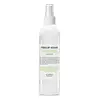Phillip Adam Leave-In Conditioner Versus Shea Moisture Jamaican Black Castor Oil Strengthen & Restore Leave-In Conditioner
What's inside
What's inside
 Key Ingredients
Key Ingredients

No key ingredients
 Benefits
Benefits

 Concerns
Concerns

 Ingredients Side-by-side
Ingredients Side-by-side

Water
Skin ConditioningRicinus Communis Seed Oil
MaskingStearyl Alcohol
EmollientCetyl Alcohol
EmollientBehentrimonium Chloride
PreservativeButyrospermum Parkii Butter
Skin ConditioningCocos Nucifera Oil
MaskingDicaprylyl Ether
EmollientPanthenol
Skin ConditioningHydrolyzed Rice Protein
Skin ConditioningSimmondsia Chinensis Seed Oil
EmollientHydrolyzed Keratin
HumectantHydroxyethylcellulose
Emulsion StabilisingAdansonia Digitata Seed Oil
EmollientGlycerin
HumectantAloe Barbadensis Leaf Juice
Skin ConditioningMacadamia Ternifolia Seed Oil
EmollientMauritia Flexuosa Fruit Oil
Skin ConditioningVinegar
Mentha Piperita Leaf Extract
Skin ConditioningTrifolium Pratense Flower Extract
AstringentNiacin
SmoothingTocopheryl Acetate
AntioxidantHydrolyzed Vegetable Protein Pg-Propyl Silanetriol
Skin ConditioningYeast Extract
Skin ConditioningCaprylyl Glycol
EmollientCaprylhydroxamic Acid
Parfum
MaskingWater, Ricinus Communis Seed Oil, Stearyl Alcohol, Cetyl Alcohol, Behentrimonium Chloride, Butyrospermum Parkii Butter, Cocos Nucifera Oil, Dicaprylyl Ether, Panthenol, Hydrolyzed Rice Protein, Simmondsia Chinensis Seed Oil, Hydrolyzed Keratin, Hydroxyethylcellulose, Adansonia Digitata Seed Oil, Glycerin, Aloe Barbadensis Leaf Juice, Macadamia Ternifolia Seed Oil, Mauritia Flexuosa Fruit Oil, Vinegar, Mentha Piperita Leaf Extract, Trifolium Pratense Flower Extract, Niacin, Tocopheryl Acetate, Hydrolyzed Vegetable Protein Pg-Propyl Silanetriol, Yeast Extract, Caprylyl Glycol, Caprylhydroxamic Acid, Parfum
 Reviews
Reviews

Ingredients Explained
These ingredients are found in both products.
Ingredients higher up in an ingredient list are typically present in a larger amount.
This ingredient is a preservative and often used for it's anti-static properties. You'll most likely see this ingredient in hair conditioners.
It does not cause irritation or sensitization in leave-on products at 1-5%.
Glycerin is already naturally found in your skin. It helps moisturize and protect your skin.
A study from 2016 found glycerin to be more effective as a humectant than AHAs and hyaluronic acid.
As a humectant, it helps the skin stay hydrated by pulling moisture to your skin. The low molecular weight of glycerin allows it to pull moisture into the deeper layers of your skin.
Hydrated skin improves your skin barrier; Your skin barrier helps protect against irritants and bacteria.
Glycerin has also been found to have antimicrobial and antiviral properties. Due to these properties, glycerin is often used in wound and burn treatments.
In cosmetics, glycerin is usually derived from plants such as soybean or palm. However, it can also be sourced from animals, such as tallow or animal fat.
This ingredient is organic, colorless, odorless, and non-toxic.
Glycerin is the name for this ingredient in American English. British English uses Glycerol/Glycerine.
Learn more about GlycerinPanthenol is a common ingredient that helps hydrate and soothe the skin. It is found naturally in our skin and hair.
There are two forms of panthenol: D and L.
D-panthenol is also known as dexpanthenol. Most cosmetics use dexpanthenol or a mixture of D and L-panthenol.
Panthenol is famous due to its ability to go deeper into the skin's layers. Using this ingredient has numerous pros (and no cons):
Like hyaluronic acid, panthenol is a humectant. Humectants are able to bind and hold large amounts of water to keep skin hydrated.
This ingredient works well for wound healing. It works by increasing tissue in the wound and helps close open wounds.
Once oxidized, panthenol converts to pantothenic acid. Panthothenic acid is found in all living cells.
This ingredient is also referred to as pro-vitamin B5.
Learn more about PanthenolThis oil comes from the seeds of the desert shrub called Jojoba. It is more commonly known as jojoba oil, a non-comedogenic oil.
Jojoba oil does not contain fragrance and has many fatty-acids, making it a great soothing ingredient.
It also contains Vitamin E, a great moisturizing ingredient. Vitamin E is also an antioxidant and protects your skin against oxidative damage.
This ingredient humectant properties, meaning it helps draw moisture from the air. This helps keep your skin hydrated.
While jojoba has antibacterial properties, it is only able to kill some strains of bacteria.
Studies also show it helps in wound healing. In fact, Indigenous cultures have used jojoba as a moisturizer and to help treat burns for centuries.
Fun fact: Jojoba oil similar to natural human skin sebum, so it has a great effect on dry skin. It is also promising with helping to regulate sebum production.
Due to its fatty acid content, Jojoba oil may not be fungal acne safe. We recommend speaking with a professional if you have any concerns.
Learn more about Simmondsia Chinensis Seed OilIn cosmetics, vinegar is often used to help adjust the pH of a product. It is also a light exfoliant. The pH of your skin is important to maintain a healthy skin barrier.
Vinegar is created by the process of double-fermentation. It is an aqueous solution consisting mostly of water and acetic acid. Typically, vinegar contains anywhere from 5-8% acetic acid.
Other components include small amounts of contains small amounts of tartaric acid and citric acid. Depending on what is used to ferment the vinegar, it can have traces of flavoring as well.
Learn more about VinegarWater. It's the most common cosmetic ingredient of all. You'll usually see it at the top of ingredient lists, meaning that it makes up the largest part of the product.
So why is it so popular? Water most often acts as a solvent - this means that it helps dissolve other ingredients into the formulation.
You'll also recognize water as that liquid we all need to stay alive. If you see this, drink a glass of water. Stay hydrated!
Learn more about Water